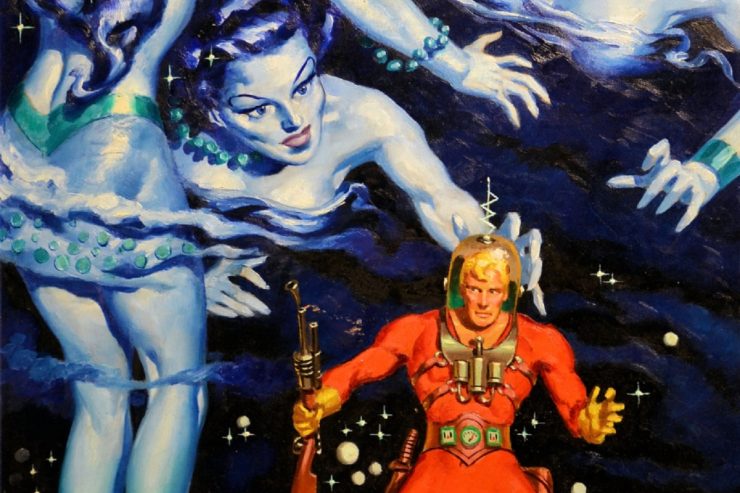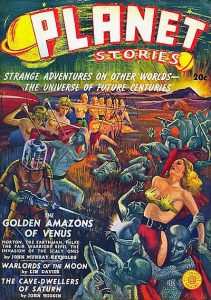 Although Fiction House had been around since the 1920s, it waited until 1939 to enter the science-fiction field. A year before, it had joined the comic book industry with Jumbo Comics, home to Sheena, “Queen of the Jungle.” Perhaps to hedge its bets, the publisher launched a science-fiction pulp, Planet Stories, and a science-fiction comic book, Planet Comics, at the same time.
Although Fiction House had been around since the 1920s, it waited until 1939 to enter the science-fiction field. A year before, it had joined the comic book industry with Jumbo Comics, home to Sheena, “Queen of the Jungle.” Perhaps to hedge its bets, the publisher launched a science-fiction pulp, Planet Stories, and a science-fiction comic book, Planet Comics, at the same time.
Over the years, Fiction House had developed a reputation for offering action-packed stories of adventure in its pulps. Planet Stories would prove to be no exception to this rule. Over its 71 issues, the rough-paper magazine would be home to countless science-fiction adventure stories called “space operas.”
In her introduction to The Best of Planet Stories #1, acclaimed author and screenwriter Leigh Brackett writes:
Planet, unashamedly, published “space opera”. . . . a story that has an element of adventure. . . . of great courage and daring, of battle against the forces of darkness and the unknown . . . The so-called space opera is the folk-tale, the hero-tale, of our particular niche in history. . . . These stories served to stretch our little minds, to draw us out beyond our narrow skies into the vast glooms of interstellar space, where the great suns ride in splendor and the bright nebulae fling their veils of fire parsecs-long across the universe; where the Coal-sack and the Horsehead make patterns of black mystery; where the Cepheid variables blink their evil eyes and a billion nameless planets may harbor life-forms infinitely numerous and strange.
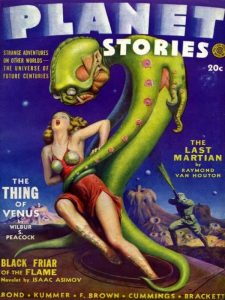 Running from 1939 to 1955, the early issues of Planet Stories featured writers such as Nelson Bond, Ray Cummings, John Russell Fearn, Neil R. Jones, Ed Earl Repp, and Ross Rocklynne. By the middle forties, Leigh Brackett and Ray Bradbury reigned supreme with the former offering seventeen “science fantasies,” while the latter introduced readers to his vision of Mars. They were joined by less-acclaimed authors such as Alfred Coppel, Gardner F. Fox, Henry Hasse, Carl Jacobi, Emmett McDowell, and Basil Wells. The late forties and early fifties found the magazine publishing work by Poul Anderson, James Blish, Philip K. Dick, Chad Oliver, Mack Reynolds, Theodore Sturgeon, Bryce Walton, and other greats who would help to develop science fiction’s modern era.
Running from 1939 to 1955, the early issues of Planet Stories featured writers such as Nelson Bond, Ray Cummings, John Russell Fearn, Neil R. Jones, Ed Earl Repp, and Ross Rocklynne. By the middle forties, Leigh Brackett and Ray Bradbury reigned supreme with the former offering seventeen “science fantasies,” while the latter introduced readers to his vision of Mars. They were joined by less-acclaimed authors such as Alfred Coppel, Gardner F. Fox, Henry Hasse, Carl Jacobi, Emmett McDowell, and Basil Wells. The late forties and early fifties found the magazine publishing work by Poul Anderson, James Blish, Philip K. Dick, Chad Oliver, Mack Reynolds, Theodore Sturgeon, Bryce Walton, and other greats who would help to develop science fiction’s modern era.
Perhaps it was Planet Stories’ emphasis on cover art with a strong dose of sex — usually imagined by Allen Anderson or Frank Kelly Freas — that helped turn “space opera” into a pejorative term. Per Leigh Brackett, “It was fashionable for a while, among certain elements of science-fiction fandom, to hate Planet Stories. They hated the magazine, apparently, because it was not Astounding Stories.”
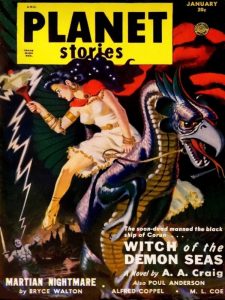 For seventy-one issues, rather than aiming for the cerebrum, Planet Stories tugged at the heart.
For seventy-one issues, rather than aiming for the cerebrum, Planet Stories tugged at the heart.
Beginning at 9:30 PM on Friday, August 5, we hope you’ll join PulpFest 50 for “Planet Stories and the Romance of Space.” Sara-Light Waller, a regular contributor to our website and The Pulpster, will inform and entertain us with a look at the first and longest-lived of the three Fiction House science fiction pulps, Planet Stories. It’s part of our salute to the Fiction House line of pulp magazines and comic books on the occasion of the publisher’s 100th anniversary.
A professional journalist and illustrator with over thirty years of experience, Sara Light-Waller is an accomplished new-pulp fiction author/illustrator with two books out and more on the way. She is also the winner of the 2020 Cosmos Prize for her illustrated short story, “Battle at Neptune.” A huge pulp fan, Sara is especially fond of science fiction pulps. The extent of her pulp fandom can best be measured by the oversized rendition of Frank R. Paul’s August 1928 Amazing Stories cover that she painted on her garage. Sara is also a member of the PulpFest organizing committee.
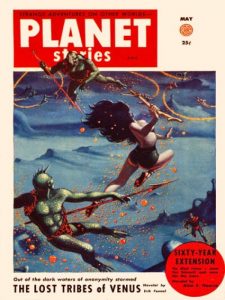 The general public is welcome to attend our evening programming events. To learn more about our schedule, please click the Programming button at the top of this page.
The general public is welcome to attend our evening programming events. To learn more about our schedule, please click the Programming button at the top of this page.
If you would like to register as a dealer at this year’s PulpFest, we’ve run out of tables. Please contact Jack Cullers ASAP to be added to our waiting list. You can reach him at jassways@woh.rr.com or jack@pulpfest.com.
To enjoy our dealers’ room, join PulpFest 50 by clicking the Registration button at the top of this page. And don’t forget to book a room at the DoubleTree by Hilton Pittsburgh — Cranberry in Mars, Pennsylvania. They’re going fast! Remember, you must book your room by 11:59 PM on Tuesday, July 12, to get the special convention rate.
When Fiction House debuted Planet Stories with its Winter 1939 issue, they turned to artist Stanley Albert Drake for the magazine’s cover art. Best known for creating “The Heart of Juliet Jones,” a daily comic strip that eventually ran in over 600 newspapers, it is believed that Drake painted the cover art for the first six issues of Planet Stories.
Born a nobleman in his native Hungary, Alexander Leydenfrost came to the United States in 1923. The artist painted two covers for Planet Stories — the Spring 1942 issue, pictured here, and the Fall 1942 number. Leydenfrost’s cover for the spring issue was reused by Fiction House in 1953 for the first of two issues of Tops in Science Fiction. Reprinting stories drawn from the pages of Planet, it was the third of the publisher’s three science fiction pulps.
Allen Anderson was the leading cover artist for Planet Stories, painting more than thirty covers for the magazine, including the January 1951 number and our featured image, reproduced from Anderson’s original art for the January 1953 issue. He was also painted 7 of the eleven covers for Two Complete Science-Adventure Books, the remaining Fiction House science fiction pulp. Each issue actually featured two cover paintings, with a diagonal lightning bolt dividing them. Additionally, Anderson painted many western covers for the publisher’s Action Stories, Indian Stories, Lariat Story Magazine, North•West Romances, Tops in Western Stories, and Two Western Action Books, as well as a few covers for Detective Book Magazine, Wings, and other Fiction House pulps.
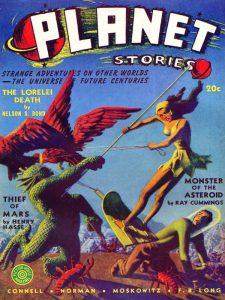 The winner of 11 Hugo Awards and the second artist to be inducted into the Science Fiction Hall of Fame, Frank Kelly Freas followed Allen Anderson as the final cover artist for Planet Stories. He painted the magazine’s last eleven covers, including the May 1954 number. He also contributed the last four covers for Two Complete Science-Adventure Books. Lastly, his cover art for the Fall 1953 number of Tops in Science Fiction — the second of two issues — was adapted by editor William Lampkin for the 29th issue of The Pulpster. Freas also contributed to many other science fiction pulps and digests. From 1957 through 1962, he painted nearly every cover for Mad magazine.
The winner of 11 Hugo Awards and the second artist to be inducted into the Science Fiction Hall of Fame, Frank Kelly Freas followed Allen Anderson as the final cover artist for Planet Stories. He painted the magazine’s last eleven covers, including the May 1954 number. He also contributed the last four covers for Two Complete Science-Adventure Books. Lastly, his cover art for the Fall 1953 number of Tops in Science Fiction — the second of two issues — was adapted by editor William Lampkin for the 29th issue of The Pulpster. Freas also contributed to many other science fiction pulps and digests. From 1957 through 1962, he painted nearly every cover for Mad magazine.
Other artists who contributed covers to Planet Stories included Hannes Bok, Albert Drake, Virgil Finlay, George Gross, Graham Ingels, Chester Martin, H. L. Parkhurst, Jerome Rozen, Norman Saunders, and Herman Beeson Vestal. Bok’s only cover for the magazine — dated Winter 1941/42 — is pictured above. He was a leading artist for the science fiction and fantasy pulps, digests, and fanzines, as well as an author.

